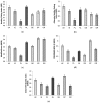Association between Diet-Quality Scores, Adiposity, Total Cholesterol and Markers of Nutritional Status in European Adults: Findings from the Food4Me Study
- PMID: 29316612
- PMCID: PMC5793277
- DOI: 10.3390/nu10010049
Association between Diet-Quality Scores, Adiposity, Total Cholesterol and Markers of Nutritional Status in European Adults: Findings from the Food4Me Study
Abstract
Diet-quality scores (DQS), which are developed across the globe, are used to define adherence to specific eating patterns and have been associated with risk of coronary heart disease and type-II diabetes. We explored the association between five diet-quality scores (Healthy Eating Index, HEI; Alternate Healthy Eating Index, AHEI; MedDietScore, MDS; PREDIMED Mediterranean Diet Score, P-MDS; Dutch Healthy Diet-Index, DHDI) and markers of metabolic health (anthropometry, objective physical activity levels (PAL), and dried blood spot total cholesterol (TC), total carotenoids, and omega-3 index) in the Food4Me cohort, using regression analysis. Dietary intake was assessed using a validated Food Frequency Questionnaire. Participants (n = 1480) were adults recruited from seven European Union (EU) countries. Overall, women had higher HEI and AHEI than men (p < 0.05), and scores varied significantly between countries. For all DQS, higher scores were associated with lower body mass index, lower waist-to-height ratio and waist circumference, and higher total carotenoids and omega-3-index (p trends < 0.05). Higher HEI, AHEI, DHDI, and P-MDS scores were associated with increased daily PAL, moderate and vigorous activity, and reduced sedentary behaviour (p trend < 0.05). We observed no association between DQS and TC. To conclude, higher DQS, which reflect better dietary patterns, were associated with markers of better nutritional status and metabolic health.
Keywords: Dutch Healthy Diet Index; Healthy Eating Index; Mediterranean Diet Score; diet scores; dried blood spots; metabolic health; nutritional biomarkers; personalized nutrition.
Conflict of interest statement
T.E.G. is founder, stockowner and C.E.O. of Vitas; C.A.D. is founder, board member, stockowner, and consultant for Vitas Ltd. None of the other authors reports a conflict of interest.
Figures

Similar articles
-
Capturing health and eating status through a nutritional perception screening questionnaire (NPSQ9) in a randomised internet-based personalised nutrition intervention: the Food4Me study.Int J Behav Nutr Phys Act. 2017 Dec 11;14(1):168. doi: 10.1186/s12966-017-0624-6. Int J Behav Nutr Phys Act. 2017. PMID: 29228998 Free PMC article.
-
Healthy eating index versus alternate healthy index in relation to diabetes status and health markers in U.S. adults: NHANES 2007-2010.Nutr J. 2019 Apr 17;18(1):26. doi: 10.1186/s12937-019-0450-6. Nutr J. 2019. PMID: 30995902 Free PMC article.
-
Association Between Dietary Patterns and Cognitive Function in Midlife Adults: The Bogalusa Heart Study.Nutrients. 2025 May 10;17(10):1636. doi: 10.3390/nu17101636. Nutrients. 2025. PMID: 40431376 Free PMC article.
-
Mediterranean Diet Adherence and Genetic Background Roles within a Web-Based Nutritional Intervention: The Food4Me Study.Nutrients. 2017 Oct 11;9(10):1107. doi: 10.3390/nu9101107. Nutrients. 2017. PMID: 29019927 Free PMC article. Clinical Trial.
-
Indicators for the evaluation of diet quality.Nutr Hosp. 2015 Feb 26;31 Suppl 3:128-44. doi: 10.3305/nh.2015.31.sup3.8761. Nutr Hosp. 2015. PMID: 25719781 Review.
Cited by
-
Determinants of Diet Quality in Adolescents: Results from the Prospective Population-Based EVA-Tyrol and EVA4YOU Cohorts.Nutrients. 2023 Dec 18;15(24):5140. doi: 10.3390/nu15245140. Nutrients. 2023. PMID: 38140399 Free PMC article.
-
Higher Maternal Diet Quality during Pregnancy and Lactation Is Associated with Lower Infant Weight-For-Length, Body Fat Percent, and Fat Mass in Early Postnatal Life.Nutrients. 2019 Mar 15;11(3):632. doi: 10.3390/nu11030632. Nutrients. 2019. PMID: 30875943 Free PMC article.
-
Motor function is the primary driver of the associations of sarcopenia and physical frailty with adverse health outcomes in community-dwelling older adults.PLoS One. 2021 Feb 2;16(2):e0245680. doi: 10.1371/journal.pone.0245680. eCollection 2021. PLoS One. 2021. PMID: 33529220 Free PMC article.
-
High adherence to the Mediterranean diet and Alternative Healthy Eating Index are associated with reduced odds of metabolic syndrome and its components in participants of the ORISCAV-LUX2 study.Front Nutr. 2022 Dec 13;9:1087985. doi: 10.3389/fnut.2022.1087985. eCollection 2022. Front Nutr. 2022. PMID: 36583217 Free PMC article.
-
Development and validation of a Brief Diet Quality Assessment Tool in the French-speaking adults from Quebec.Int J Behav Nutr Phys Act. 2019 Aug 6;16(1):61. doi: 10.1186/s12966-019-0821-6. Int J Behav Nutr Phys Act. 2019. PMID: 31387609 Free PMC article.
References
Publication types
MeSH terms
Substances
Grants and funding
LinkOut - more resources
Full Text Sources
Other Literature Sources
Medical
Research Materials
Miscellaneous

